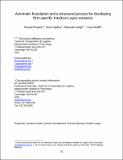| dc.contributor.author | Phadnis, Shardul | |
| dc.contributor.author | Caplice, Christopher | |
| dc.contributor.author | Singh, Mahender | |
| dc.contributor.author | Sheffi, Yosef | |
| dc.date.accessioned | 2017-09-27T17:48:07Z | |
| dc.date.available | 2017-09-27T17:48:07Z | |
| dc.date.issued | 2014-07 | |
| dc.date.submitted | 2014-06 | |
| dc.identifier.issn | 0040-1625 | |
| dc.identifier.uri | http://hdl.handle.net/1721.1/111651 | |
| dc.description.abstract | This paper presents an axiomatic foundation for developing firm-specific scenarios in the tradition of the Intuitive Logics School (ILS), a structured scenario creation process built on that foundation, and its application to a case. The ILS outlines a high-level scenario-development process, but without a theoretical basis or prescriptions for executing different process steps. The lack of theoretical grounding has led to a proliferation of methods for developing scenarios, without any basis for comparing them. We fill this gap in the literature by articulating a set of axioms characterizing the nature of human knowledge about the business environment and scenarios as depictions of that environment. Using this theoretical foundation, we devise a structured process for developing scenarios. Finally, we demonstrate this process by applying it to develop four scenarios for a firm in the U.S. healthcare sector. | en_US |
| dc.language.iso | en_US | |
| dc.publisher | Elsevier | en_US |
| dc.relation.isversionof | http://dx.doi.org/10.1016/j.techfore.2014.06.019 | en_US |
| dc.rights | Creative Commons Attribution-NonCommercial-NoDerivs License | en_US |
| dc.rights.uri | http://creativecommons.org/licenses/by-nc-nd/4.0/ | en_US |
| dc.source | Prof. Sheffi via Angie Locknar | en_US |
| dc.title | Axiomatic foundation and a structured process for developing firm-specific Intuitive Logics scenarios | en_US |
| dc.type | Article | en_US |
| dc.identifier.citation | Phadnis, Shardul et al. “Axiomatic Foundation and a Structured Process for Developing Firm-Specific Intuitive Logics Scenarios.” Technological Forecasting and Social Change 88 (October 2014): 122–139 © 2014 Elsevier Inc | en_US |
| dc.contributor.department | Massachusetts Institute of Technology. Center for Transportation & Logistics | en_US |
| dc.contributor.approver | Sheffi, Yossi | en_US |
| dc.contributor.mitauthor | Phadnis, Shardul | |
| dc.contributor.mitauthor | Caplice, Christopher | |
| dc.contributor.mitauthor | Singh, Mahender | |
| dc.contributor.mitauthor | Sheffi, Yosef | |
| dc.relation.journal | Technological Forecasting and Social Change | en_US |
| dc.eprint.version | Author's final manuscript | en_US |
| dc.type.uri | http://purl.org/eprint/type/JournalArticle | en_US |
| eprint.status | http://purl.org/eprint/status/PeerReviewed | en_US |
| dspace.orderedauthors | Phadnis, Shardul; Caplice, Chris; Singh, Mahender; Sheffi, Yossi | en_US |
| dspace.embargo.terms | N | en_US |
| dc.identifier.orcid | https://orcid.org/0000-0002-3936-5440 | |
| mit.license | PUBLISHER_CC | en_US |
